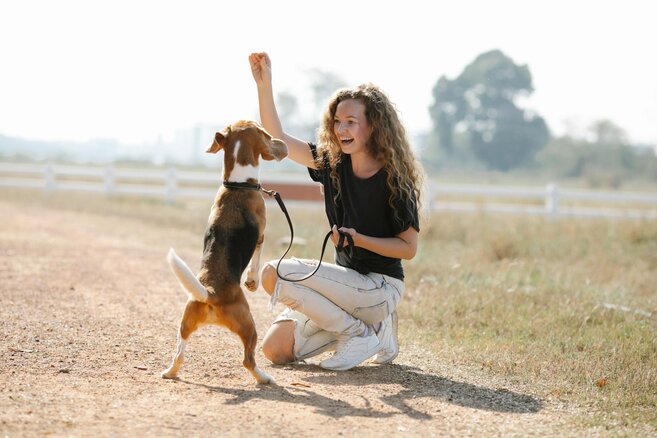Beagle Breed Guide: Characteristics, History & Care
Cornell University College of Veterinary Medicine
Beagle dogs are one of the most recognizable dog breeds in the U.S. Because of their compact size and gentle nature, they fit in many homes and lifestyles. Beagles are also great with children and other pets but do require plenty of exercise and are known to roam whenever they smell something irresistible, whether it be food or a small animal to chase.
See which pet insurance is right for your best friend.
So, are Beagles good dogs? Read on to learn more about the Beagle temperament and breed characteristics, including their physical appearance, personality, grooming requirements, history, and more.
Table of Contents
- Beagle characteristics
- Physical appearance
- Personality
- Lifespan
- Beagle care
- Training and exercise
- Grooming
- Nutrition
- Living with Bealges
- Common Beagle health issues
- Beagle breed history
- Where to adopt or buy a beagle
- Key takeaways
Pro Tip: Beagles are scent hounds that often love to track down any smell they come across. Unfortunately, this type of behavior can lead to accidents, but enrolling your dog in pet insurance means that you’ll have a helping hand to cover unexpected vet costs .
Beagle characteristics
Physical appearance
Beagle dogs are compact and come in two size variations: the smaller variety is no more than 13 inches at the shoulders and weighs between 22 and 30 pounds on average; the larger variety is between 13 and 15 inches tall with a healthy weight range up to 35 lbs. The anatomy of a Beagle has a slightly domed skull, squarish muzzle, broad nose, and long, droopy ears. They have a straight back, deep chest, and moderately long tail.
Most Beagles are tricolor with black, light brown, and white markings. However, there are also two-toned members of the breed known as Lemon Beagles that features a predominantly white coat with patches of tan fur.
Temperament
The Beagle temperament is well known for being intelligent, social, and great with kids . They love company, but can become destructive or bark incessantly if left alone. These dogs also tend to be easily excitable which makes them prone to howling. Although Beagles can be somewhat cautious around strangers, they tend to warm up quickly with ready displays of affection (which may make them poor guard dogs).
As hound dogs, Beagles have an impulse to follow their noses and they are happiest when tracking a scent. This leads them to become easily distracted, so they may be more difficult to train than other dogs. Owners must be extremely vigilant when training Beagle puppies to prevent them from wandering off or eating things they’re not supposed to.
Lifespan
On average, the Beagle lifespan is between 12 and 15 years , with a median life expectancy of 13.5 years. How long your Beagle lives will depend on genetics as well as how you care for them. The good news is that some of the leading causes of death for this dog breed are easily avoidable.

Beagle care tips
Training and exercise
Beagles are quite active and require daily exercise. Because they were bred to work in packs, these dogs enjoy having someone to play with, both human and canine. Beagles often wander off, so you need to make sure that the exercise area is fenced and your pup is supervised.
In addition, leashed walks only are highly recommended, because even well trained Beagles may not be able to resist the urge to run off in pursuit of an interesting scent such as a squirrel or rabbit, even if you cannot see or hear the animal. Puppy training classes and early socialization are highly recommended. Beagles can be somewhat stubborn and difficult to train but with lots of patience, positive reinforcement, and some treats, they can become wonderful canine companions.
Grooming
Beagles have a smooth and dense double coat that gets heavier in the winter. They shed moderately throughout the entire year and more profusely during spring. Weekly brushing is required to remove the loose hair and promote the growth of new hair.
They don't need frequent baths unless they get particularly messy. As with all breeds, their nails should be trimmed on a regular basis in order to prevent pain when your pet is running and walking and reduce the risk of arthritis later in life.
Nutrition
Most Beagles eat up to 3/4 cup of dry dog food twice a day for adequate caloric intake. This amount will vary depending on your pet’s age, size, level of activity, and other factors so what type of food you feed your dog and in what quantity should always be discussed with your veterinarian. Beagles are known for their insatiable appetite, so you will need to keep an eye on your pet’s weight in order to prevent them from becoming overweight.
The members of this breed are also known for their ability to sniff out and eat anything they can find. For this reason, you need to ensure that your pantry, cupboards, kitchen trash cans, and other places where you might keep human or dog food are well-secured. Eating human foods or trash can make your Beagle very sick potentially requiring emergency surgery or hospitalization.
Living with Beagle Dogs
Beagles are very gentle with children, which makes them excellent family dogs . They also get along with other animals, including cats. They are quite vocally expressive and tend to bark a lot. Like other dogs, barking is their way of communicating their feelings.
Luckily, this behavior can be kept under control with consistent training along with plenty of daily mental and physical exercise for your pup. In order to rein in the Beagles’ voracious appetite and prevent them from running off after an interesting scent, it’s a good idea to secure all the exits in your home and make sure your yard is fenced.
Common Beagle health issues
Although Beagles are typically healthy, some members of the breed experience more serious health conditions. Most commonly, Beagles suffer from issues associated with the joints and bones , such as hip dysplasia , patellar luxation, and invertible disc disease. Beagles are also prone to eye issues, such as glaucoma , cherry eye, distichiasis, and progressive retinal atrophy. Certain neurological issues are also common such as epilepsy, which can be caused by hypothyroidism.
Many Beagles are likely to experience minor health issues such as ear infections which can be quite foul-smelling but are easy to treat with timely veterinary attention. Finally, due to their big appetite, Beagles are prone to obesity, a condition that can lead to many major health conditions but is entirely preventable.
Pro Tip: Like all dogs, Beagles can have their share of health problems. That's why it's a good idea to enroll in dog insurance so you can get reimbursed for exam fees, diagnostics, hospitalization, surgery, and even homeopathic therapies should your pup get sick or injured.
Some people can predict the future.For everyone else, there's pet insurance.
Beagle breed history
The Beagle breed is one of the most familiar breeds in the world. According to some historians, the first records mentioning Beagles date back to the 1400s.
Beagles descend from the hunting hounds of England. The word Beagle is believed to come from the French word ‘begueule’ and was used to refer to smaller varieties of these hounds. Pocket Beagles (miniature forms of the breed) were popular among English royalty, including Queen Elizabeth I.
The breed was officially recognized in the 19th century, eventually becoming one of the most popular breeds. Today, it is ranked 7th on AKC’s list of most popular dog breeds. Even though some Beagles are still used for hunting, most are beloved house pets. The United States Department of Agriculture uses Beagles for detecting contraband food items in luggage and the breed is also well known through Snoopy, a character from the "Peanuts" cartoon.
Where to adopt or buy a Beagle
If you’re buying a Beagle puppy, take your time to find a reputable breeder. Use the American Kennel Club search tool to find breeders who meet strict requirements. You can also visit the National Beagle Club of America’s website to find breeders. When talking to breeders, make sure to ask about any health issues in the pup’s bloodline.
Another way to get a Beagle dog is to adopt a rescue. Rescued dogs often come neutered/spayed, and fully vaccinated. Many of them are also socialized and likely to know basic commands.
Check your local animal shelter to see if there is a Beagle in need of a home. You can also check out regional organizations, such as Triangle Beagle Rescue in North Carolina and the nation-wide Beagle Freedom Project .
Key Takeaways
- Beagles are friendly and playful dogs recognizable by their big brown eyes and floppy ears. They are great with children as well as other animals and can fit perfectly in just about any home.
- Bred as scent hounds, Beagles are known for always searching for an interesting scent to follow. Because of this, your household food and garbage need to be properly secured, and fenced in yards are highly recommended. Beagles require daily exercise and, despite being a smart breed, they can be quite slow to house train.
- The breed is considered to be healthy in general, with a life expectancy of 12 to 15 years. However, just like all dog breeds, Beagles can have certain health issues such as eye infections, ear infections, hip dysplasia, epilepsy, etc.
- Consider your lifestyle before buying or adopting a Beagle. Talk to a rescue group or Beagle breeder to see if this is the right choice for your family.
See which pet insurance is right for your best friend.
Do you want to find the best pet insurance?
Let's analyze your pet's breed, age, and location to find the right coverage and the best savings. Ready?
Analyze My PetAbout Pawlicy Advisor
The pet insurance marketplace endorsed by veterinarians, at Pawlicy Advisor we make buying the best pet insurance easier. By comparing personalized coverage and pricing differences we can save you a ton of money, up to 83% in some instances!
Instantly Compare Pet Insurance Plans
Guides
Determine If Pet Insurance Is Worth It
Comparison Charts
Find Your State
Dog Insurance
Cornell University College of Veterinary Medicine
Aliyah Diamond has more than ten years of experience in animal hospitals - working with dozens of species from dogs and cats, to elephants and snow leopards. Her lifelong passion for helping animals currently has her earning her doctorate of veterinary medicine at Cornell University and helping Pawlicy Advisor educate pet parents.
